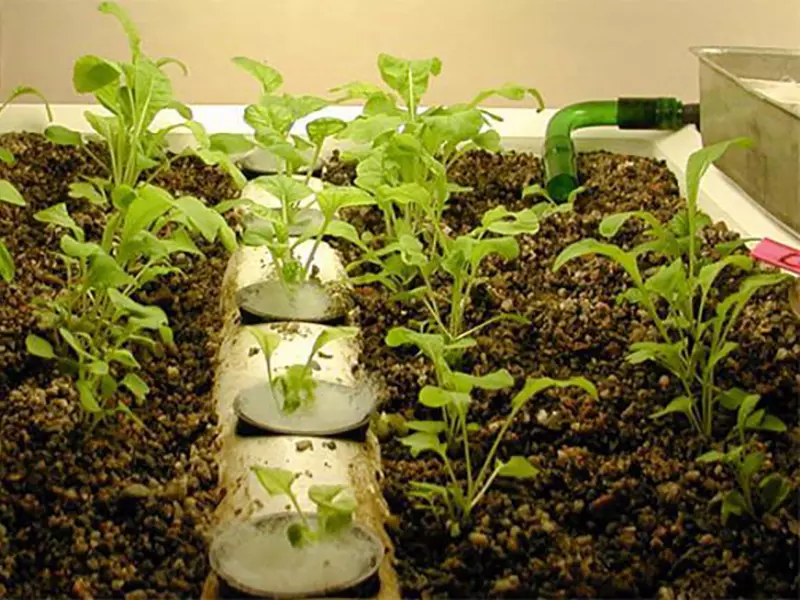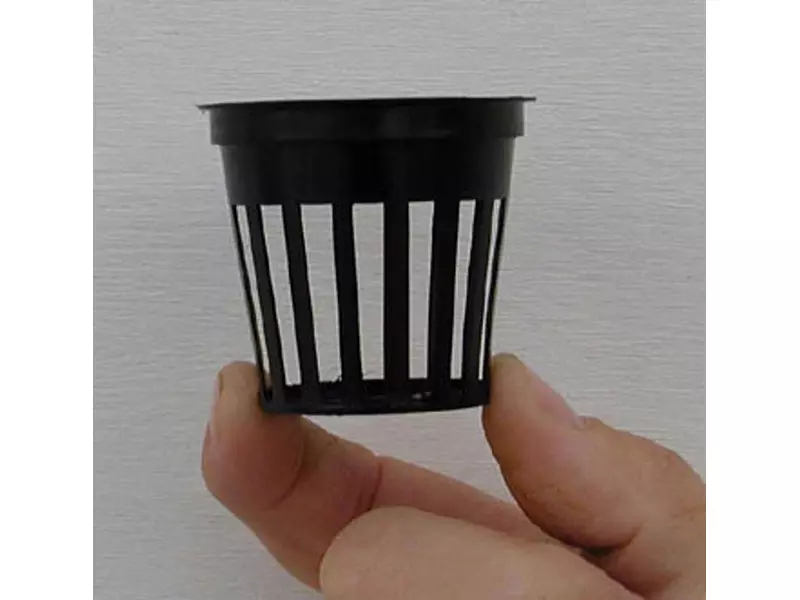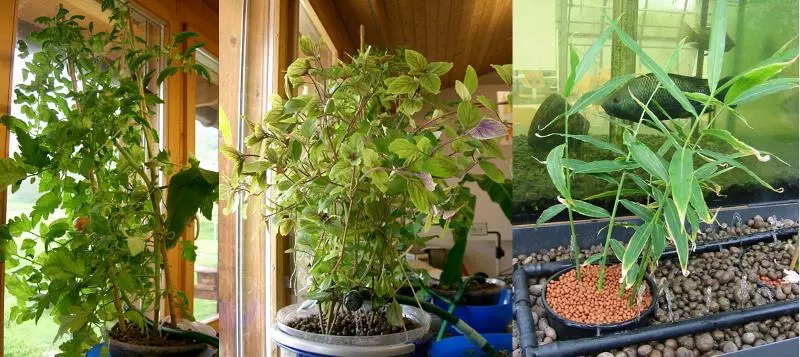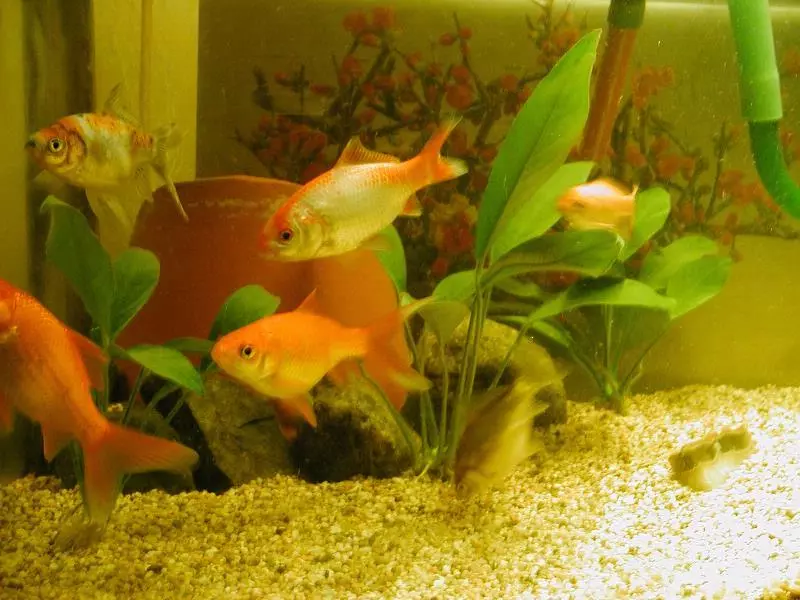Establishing fish and plants in the classroom aquaponic system
This experiment introduces the basics of plant and fish cultivation in aquaponic systems. Plants are recycling the nutrients in aquaponic systems. Pupils will learn how to prepare and cultivate different crops in the substrate (filter gravel or LECA).
Feeding the fish is a very important issue and has to be well explained regarding fish health and water quality. Before starting with this experiment you should have an aquaponic system with an already established bacterial fauna and water recirculation according to experiment 1 (Constructing a classroom aquaponic system) and experiment 2 (Starting an aquaponic system).
Learning goals
- Know how to handle plant seedlings.
- Know what has to be considered in planting seedlings into the filter beds.
- Understand the function of the plants in removing and recycling the nutrients of the water.
- Understand how to handle the fish and how to feed them.
Background information

Plants belong to the primary producers in an ecosystem. They are able to convert sunlight, CO2 and mineral nutrients into new biomass which finally provides nutrition to animals and other consumers in the food web. In aquaponic systems plants are converting the nutrients, that come from fish excrements and have been decomposed by the filter bacteria, into new biomass which makes them grow.
Fish need food like any other living creature. We humans breath and thus release carbon dioxide into the air. Fish also breath, using gills instead of lungs, and release carbon dioxide into the water. But more, the gills release ammonium and thus effect the water quality. It is important that the fish are not overfed, for the food leftovers will rot in the water, which will harm the fish.
Time requirement
It will take 2-3 week to produce the seedlings (you can also buy them ready-made in a shop) and 2-4 hours to plant them into the system.
Material requirement
- 1 aquaponic system with established filter fauna (conducted experiment 1 and experiment 2)
- 3-4 Goldfish
- 10-20 plant seedlings of lettuce, tomatoes and ornamental plants. Some of them you will plant into the filter and others you will use for analyses.
- 1 assimilation light (only required in case of bad natural light conditions)
- 1 seed box and some small pots in case you intend to produce the seedling yourself
Let's start

First sow the seeds! It takes between 1 - 3 weeks to get seedlings big enough to transfer them to the plant boxes in the aquaponic, so you better start sowing now. Try 20 lettuce seeds and 20 basil seeds. Tomatoes are normally too big for a small classroom system, but you could try some, too. Sow in a small pot looking like the one illustrated below. You can sow your seeds in plant-soil or peat moss. We have also tried, and succeeded, sowing in ordinary cotton, filterwool for the aquarium or rockwool. As an alternative you could go to the supermarket and buy some ready grown vegetables like basil or parsley in pots.


Fetch the fish! Three to six weeks after the start of the biofilter, the nitrite value should be 0 mg/l and the nitrate value should be between 10 - 100 mg/l. Now it is time to fetch the fish. We recommend 4 goldfish to start with.
Fish should be transported in a non-transparent, dark plastic sack. Ideally, your fish dealer will put them in a special plastic bag with no edges (danger of squeezing fish), leave 2/3 of the bag void (air contains more oxygen then water and functions as an oxygen reservoir!), and wrap the bag with newspaper. This both reduces stress due to light flashes, and serves as insulation. The water temperature should not drop by more than 3 °C during transportation. If you have a longer transportation distance, wrap the fish bag with terry towellings.
When placing the fish in the aquarium, minimize stress on them. Remember that the fish have to adapt to a new situation regarding temperature, pH and salt concentrations in the water. Put the bag holding your fish into the aquarium and open the bag to let oxygen in. Fill in the same amount of aquarium water that was already there, and wait for 20 minutes. That way, the temperature can balance and the fish get acclimatized slowly to the new situation. After that, you can release the fish by flushing them in the aquarium with all the water.
Proper feeding: Discuss fish feed issues with your dealer - some fish feed float and some sink. Try to assess the weight of the fish, because the daily fish feed amount should be 1 - 2 % of the fish weight. Young fish can be fed preferably 2 % daily, but for older fish reduce it to 1 % per day. Here's an example: If you want to feed 100 g fish, you should give them 1-2 g fish food per day. Split this amount of fodder into two ratios and feed your fish twice a day. When you first measure the exact amount of fodder, put it into a measuring cup and mark it. Even better would be if you cut the measuring cup on the spot of the mark, so next time you feed the fish, you can just fill it up to the top. That way, you don't always have to remeasure such small amounts of fish food. If nitrite or ammonium rises over the critical level, first you should stop feeding the fish and exchange half of the water. Do not worry about stopping the feeding, fish survive several weeks without fodder. It is important to know that overfeeding of the fish can lead to bad water quality! If after feeding your fish, you discover that they haven't eaten all of the food after 5 minutes, try to remove the remains with a fine net or a beaker.
Plant the seedlings in the plant boxes! Take the most sturdy looking seedlings and plant them in the plant boxes directly into the substrate (gravel or LECA) or in a small pot placed into the substrate up to the edge of the pot. It is important that the pot can let the roots through without any effort from the plant. It doesn't matter much if some soil or other substrate remains on the roots. Turn on the light - let the sun shine!
See and feel
- Measure the plant height of the seedlings (total height, since it is difficult to find some buds or vegetation points)
- Compare the roots and the surface organs of the different seedlings. Is there a big difference between seedlings of the same species? What about the difference between the different species?
- Be very careful when handling the fish in the aquarium. They don't like to be chased around with a net, for this causes a lot of stress to them.
- Observe your fish when feeding them. Are they hungry or not? Do they eat up all the fish fodder? Make sure not to overfeed the fish.
Didactical comments
The handling of plant seedlings and fish requires special care by pupils. After all, they are now dealing with living organisms. The interconnection between feeding the fish, fish growth, water quality and nutrient supply of plants should be well explained.
Additionally, to show pupils the importance of sunlight for plant growth, start a small experiment in placing seedlings in conventional plant pots at a different place under different light conditions.